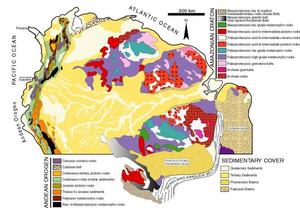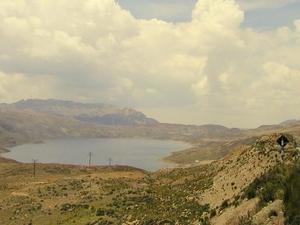Project beneficiaries
Institut de recherche pour le développement
France
Fundação Universidade de Brasília
Brazil
Stichting Koninklijk Nederlands Instituut Voor Zeeonderzoek
The Netherlands
Jacobs University Bremen Ggmbh
Germany
Imperial College London
United Kingdom
Helmholtz-Zentrum Potsdam, Deutsches GeoForschungsZentrum
Germany
Universiteit van Amsterdam
The Netherlands
Università degli Studi di Napoli Federico II
Italy
Sedimentary record and climatic history significance
 ©
UnB / compiled by Chemale et al., 2002 after Tassinari et al., 2009 and maps of Geological Survey of Peru, Equador, Colombia, Venezuela
©
UnB / compiled by Chemale et al., 2002 after Tassinari et al., 2009 and maps of Geological Survey of Peru, Equador, Colombia, Venezuela
The settlement of the Amazon sedimentary basin is directly related to the Septentrional Andean uplift that occurred between 12 to 10.5 Ma before present (Chemale et al. 2002). The Middle to Upper Miocene was also a period characterized by major changes in world climate, global geomorphology, paleobiology, among others (Willertt et al. 2006, Potter & Szatmari, 2009). From the upper Miocene to present, the Amazon River flows from the Andean Mountains to the Equatorial Margin of the Atlantic Ocean, resulting in one of the most important sedimentary accumulation in the world. The Amazon Fan has a thickness of ca. 8 km and a very high sedimentation rate, reaching an accumulation of 80 meters thick of sediments per million years. Hence, this fan is a major feature in the Brazilian equatorial margin that was formed between the Upper Tertiary and the Present. This pile of sediments overloaded the continental crust in such a way that it induced measureable deformation in the lithosphere.
A systematic survey on the suspended material and deposited sediments of the Amazon River and on the drill core/cuttings of the Amazon Fan may bring essential information on the dynamic process of the sedimentation and tectonics. This will tells us also about the history of the hydrological cycles, which have a close relationship with past climatic variations. Mountain uplift, global warming, increasing precipitation rate and river runoff will all tend to increase continental erosion and, as a result, increase sediment transport load and deposition in the Amazon delta. The evolving nature of the sediments may also reveal changes occurring in the source regions through time.
The knowledge of the present Amazon River sediment discharge and of its variability is fundamental since it can be linked to the on-going climatic and erosional processes at the regional scale. Understanding the relationships between those processes will be helpful to better interpret the observations of the past sedimentation rates. Furthermore, our study will thus provide valuable scientific parameters for the oil and gas reservoirs from other delta and fans worldwide with hydrocarbon accumulation (e.g., Niger Delta, Africa), predicting that they will certainly be applied to the hydrocarbon exploration in such areas showing many technological difficulties.
CLIM-AMAZON in the XV Brazilian Congress of Geochemistry - Brasilia 2015- 2015 Annual Meeting/ 4th Workshop and Clim-Amazon results presentation in the 6th Ore-Hybam Conference - Cusco 2015
For the CLIM-AMAZON project fencing, the 4th CLIM-AMAZON Workshop and the International Symposium on Climate and Geodynamics of Amazon Basin (2015 CLIM-AMAZON Annual Meeting) will take place in Brasilia on the 21st and 22nd of October 2015, respectively, during the XV Brazilian Geochemistry Congress (19th-22th October 2015).
The CLIM-AMAZON results will be presented also in Cusco during the 6th Ore-Hybam Conference (26th-30th October 2015).
For more information about the XV Brazilian Geochemistry Congress, click here:
http://www.sbgq.org.br/15cbgq/
For more information about the 6th Ore-Hybam conference, click here
6th HYBAM Scientific Meeting - Cusco 2015 (1.29 Mo)



